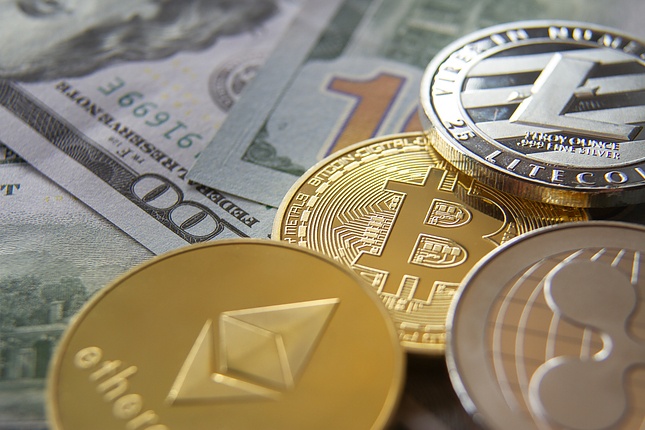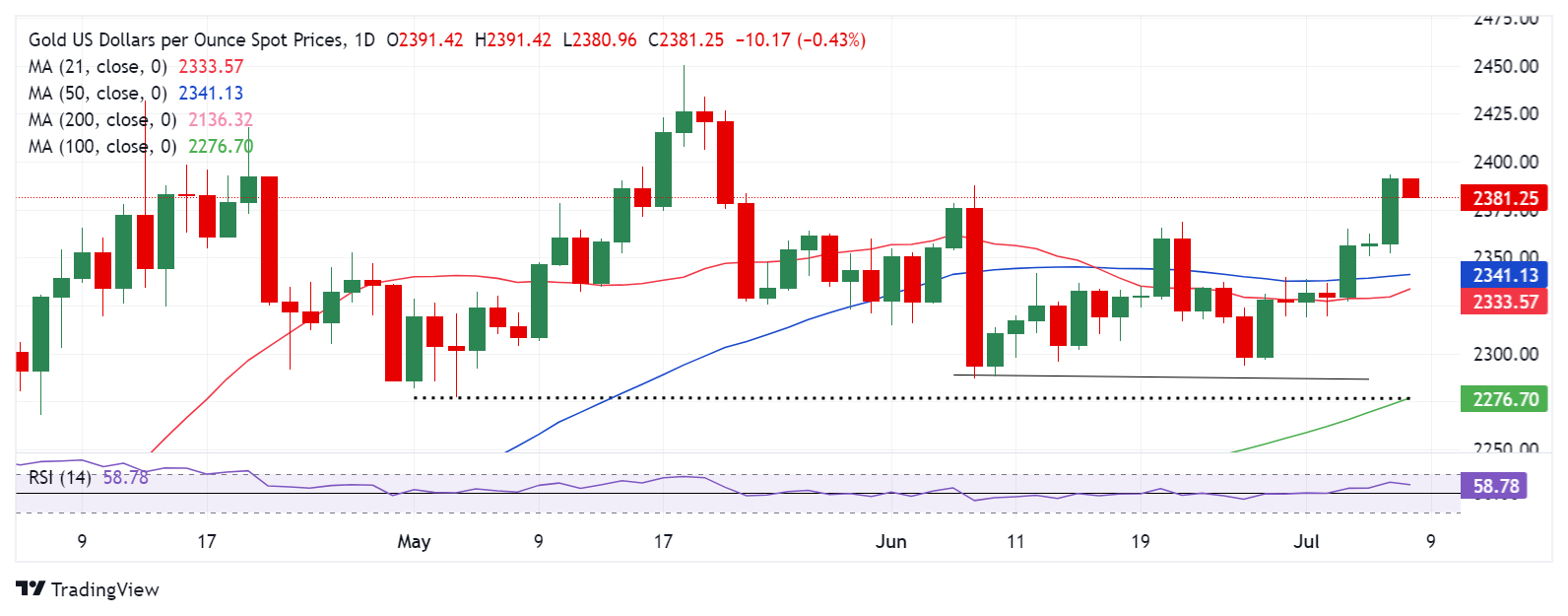- Gold price pulls back from six-week highs of $2,393 at the start of a new week.
- PBOC paused Gold buying for a second straight month in June, undermining Gold price.
- The US Dollar sticks to three-week lows even as Treasury bond yields show signs of life.
- The daily RSI holds above the 50 level, suggesting dip-buying to remain in play.
Gold price is correcting lower from near six-week highs of $2,393 set on Friday, despite a broadly subdued US Dollar (USD). A modest recovery in the US Treasury bond yields and China’s pause on Gold buying for the second consecutive month in June.
Gold price stalls uptrend on China demand concerns
Having witnessed the second straight weekly gain, Gold price sees a negative start to the week on Monday, primarily driven by fresh concerns over Gold demand from the world’s top yellow metal consumer, China. The People’s Bank of China (PBOC) said on Sunday, China held 72.80 million troy ounces of Gold at the end of June, unchanged from the end of May, the data showed. China's Gold reserves fell to $169.70 billion from $170.96 billion, per Reuters. This was the second month in a row that the PBOC refrained from adding Gold to its reserves.
Additionally, a slight recovery in the US Treasury bond yields, courtesy of a likely downslide in French bond yields, makes the non-yielding Gold price less attractive as an alternative asset. The benchmark 10-year US Treasury bond yields look to regain 4.30%, at the press time, up 0.61% on the day.
The second round of the French elections on Sunday showed a likelihood of a hung parliament, with no single party securing a majority in the lower house, according to the exit polls. France's left-wing New Popular Front coalition won the most seats in the second voting round of parliamentary elections. President Emmanuel Macron's centrist bloc was seen narrowly ahead of Marine Le Pen's RN party in the second-place battle.
Should risk-aversion intensify in the European session due to French political uncertainty, the Euro could fall further and lift the US Dollar across the board. This, in turn, could accelerate the Gold price correction.
In the absence of top-tier economic data releases, Gold price will remain at the mercy of the risk sentiment and the market’s pricing of the US Federal Reserve (Fed) interest rate-cut timing.
Currently, markets are seeing a 76% chance of a Fed rate cut in September, a tad higher than a 74% probability seen following the release of the US Nonfarm Payrolls data on Friday.
Data published by the Labor Department showed Friday that the headline NFP increased by 206,000 in June, beating the market forecast for a 190,000 gain. Despite strong June figures, April and May readings were significantly revised down by a combined 111,000. Average hourly earnings rose 3.9% year-on-year, as expected, registering its lowest since the second quarter of 2021.
The next of relevance for Gold price remains Fed Chairman Jerome Powell’s testimony on the Semi-Annual Monetary Policy Report before the Senate Banking Committee on Tuesday. Powell could once again reverberate dovish Fed expectations.
Gold price technical analysis: Daily chart
The short-term technical outlook for Gold price still remains constructive, despite the latest pullback, as the 14-day Relative Strength Index (RSI) continues to hold above the 50 level.
The previous week’s bullish range breakout took out the June high of $2,389 but the rally faced rejection just shy of the $2,400 mark.
If Gold buyers regain strength, then the six-week high of $2,393 will be retested en route the $2,400 level.
A sustained move above the latter could put the all-time high of $2,450 back in sight.
Alternatively, Gold price could challenge Friday’s low of $2,352 if the retreat gathers pace. Further down, the $2,340 demand area will come into play.
That zone is the confluence of the 50-day Simple Moving Average (SMA) and the 21-day SMA.
Gold FAQs
Gold has played a key role in human’s history as it has been widely used as a store of value and medium of exchange. Currently, apart from its shine and usage for jewelry, the precious metal is widely seen as a safe-haven asset, meaning that it is considered a good investment during turbulent times. Gold is also widely seen as a hedge against inflation and against depreciating currencies as it doesn’t rely on any specific issuer or government.
Central banks are the biggest Gold holders. In their aim to support their currencies in turbulent times, central banks tend to diversify their reserves and buy Gold to improve the perceived strength of the economy and the currency. High Gold reserves can be a source of trust for a country’s solvency. Central banks added 1,136 tonnes of Gold worth around $70 billion to their reserves in 2022, according to data from the World Gold Council. This is the highest yearly purchase since records began. Central banks from emerging economies such as China, India and Turkey are quickly increasing their Gold reserves.
Gold has an inverse correlation with the US Dollar and US Treasuries, which are both major reserve and safe-haven assets. When the Dollar depreciates, Gold tends to rise, enabling investors and central banks to diversify their assets in turbulent times. Gold is also inversely correlated with risk assets. A rally in the stock market tends to weaken Gold price, while sell-offs in riskier markets tend to favor the precious metal.
The price can move due to a wide range of factors. Geopolitical instability or fears of a deep recession can quickly make Gold price escalate due to its safe-haven status. As a yield-less asset, Gold tends to rise with lower interest rates, while higher cost of money usually weighs down on the yellow metal. Still, most moves depend on how the US Dollar (USD) behaves as the asset is priced in dollars (XAU/USD). A strong Dollar tends to keep the price of Gold controlled, whereas a weaker Dollar is likely to push Gold prices up.
Information on these pages contains forward-looking statements that involve risks and uncertainties. Markets and instruments profiled on this page are for informational purposes only and should not in any way come across as a recommendation to buy or sell in these assets. You should do your own thorough research before making any investment decisions. FXStreet does not in any way guarantee that this information is free from mistakes, errors, or material misstatements. It also does not guarantee that this information is of a timely nature. Investing in Open Markets involves a great deal of risk, including the loss of all or a portion of your investment, as well as emotional distress. All risks, losses and costs associated with investing, including total loss of principal, are your responsibility. The views and opinions expressed in this article are those of the authors and do not necessarily reflect the official policy or position of FXStreet nor its advertisers. The author will not be held responsible for information that is found at the end of links posted on this page.
If not otherwise explicitly mentioned in the body of the article, at the time of writing, the author has no position in any stock mentioned in this article and no business relationship with any company mentioned. The author has not received compensation for writing this article, other than from FXStreet.
FXStreet and the author do not provide personalized recommendations. The author makes no representations as to the accuracy, completeness, or suitability of this information. FXStreet and the author will not be liable for any errors, omissions or any losses, injuries or damages arising from this information and its display or use. Errors and omissions excepted.
The author and FXStreet are not registered investment advisors and nothing in this article is intended to be investment advice.
Recommended Content
Editors’ Picks

AUD/USD clings to recovery gains above 0.6200, focus shifts to US ISM PMI
AUD/USD sustains the recovery from two-year troughs, holding above 0.6200 in Friday's Asian trading. The pair finds footing amid a pause in the US Dollar advance but the upside appears elusive as markets turn cautious amid China concerns and ahead of US ISM PMI data.

USD/JPY eases toward 157.00 as risk sentiment sours
USD/JPY is extending pullback from multi-month high of 158.07 set on Thursday. The pair drops toward 157.00 in the Asian session on Friday, courtesy of the negative shift in risk sentiment. Markets remain concerned about China's econmic health and the upcoming policies by the Fed and the BoJ.

Gold price appreciates amid Biden's discussions about potential strikes on Iran
Gold price edges higher for the fourth consecutive session on Friday, building on a stellar performance in 2024 with gains exceeding 27%, the metal’s best annual return since 2010. This sustained rally is attributed to strong safe-haven demand amid persistent geopolitical tensions in the Middle East and the prolonged Russia-Ukraine conflict.

Bitcoin, Ethereum and Ripple eyes for a rally
Bitcoin’s price finds support around its key level, while Ethereum’s price is approaching its key resistance level; a firm close above it would signal a bullish trend. Ripple price trades within a symmetrical triangle on Friday, a breakout from which could signal a rally ahead.

Three Fundamentals: Year-end flows, Jobless Claims and ISM Manufacturing PMI stand out Premium
Money managers may adjust their portfolios ahead of the year-end. Weekly US Jobless Claims serve as the first meaningful release in 2025. The ISM Manufacturing PMI provides an initial indication ahead of Nonfarm Payrolls.

Best Forex Brokers with Low Spreads
VERIFIED Low spreads are crucial for reducing trading costs. Explore top Forex brokers offering competitive spreads and high leverage. Compare options for EUR/USD, GBP/USD, USD/JPY, and Gold.
